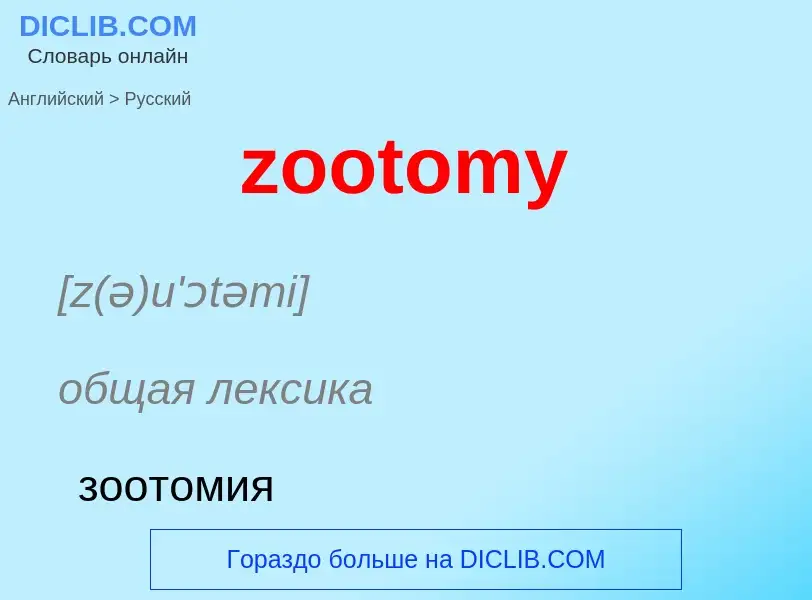Tradução e análise de palavras por inteligência artificial ChatGPT
Nesta página você pode obter uma análise detalhada de uma palavra ou frase, produzida usando a melhor tecnologia de inteligência artificial até o momento:
- como a palavra é usada
- frequência de uso
- é usado com mais frequência na fala oral ou escrita
- opções de tradução de palavras
- exemplos de uso (várias frases com tradução)
- etimologia
zootomy - tradução para russo
[z(ə)u'ɔtəmi]
общая лексика
зоотомия
анатомия животных
существительное
общая лексика
зоотомия
[ə'nætəmist]
общая лексика
анатом
медицина
прозектор
существительное
общая лексика
анатом
препаратор
прозектор
аналитик
исследователь
критик, аналитик
Definição
Wikipédia

Anatomy (from Ancient Greek ἀνατομή (anatomḗ) 'dissection') is the branch of biology concerned with the study of the structure of organisms and their parts. Anatomy is a branch of natural science that deals with the structural organization of living things. It is an old science, having its beginnings in prehistoric times. Anatomy is inherently tied to developmental biology, embryology, comparative anatomy, evolutionary biology, and phylogeny, as these are the processes by which anatomy is generated, both over immediate and long-term timescales. Anatomy and physiology, which study the structure and function of organisms and their parts respectively, make a natural pair of related disciplines, and are often studied together. Human anatomy is one of the essential basic sciences that are applied in medicine.
Anatomy is a complex and dynamic field that is constantly evolving as new discoveries are made. In recent years, there has been a significant increase in the use of advanced imaging techniques, such as MRI and CT scans, which allow for more detailed and accurate visualizations of the body's structures.
The discipline of anatomy is divided into macroscopic and microscopic. Macroscopic anatomy, or gross anatomy, is the examination of an animal's body parts using unaided eyesight. Gross anatomy also includes the branch of superficial anatomy. Microscopic anatomy involves the use of optical instruments in the study of the tissues of various structures, known as histology, and also in the study of cells.
The history of anatomy is characterized by a progressive understanding of the functions of the organs and structures of the human body. Methods have also improved dramatically, advancing from the examination of animals by dissection of carcasses and cadavers (corpses) to 20th century medical imaging techniques, including X-ray, ultrasound, and magnetic resonance imaging.



![A dissected body, lying prone on a table, by [[Charles Landseer]] A dissected body, lying prone on a table, by [[Charles Landseer]]](https://commons.wikimedia.org/wiki/Special:FilePath/An écorché figure (life-size), lying prone on a table Wellcome L0020561.jpg?width=200)
![Hyaline cartilage at high magnification ([[H&E stain]]) Hyaline cartilage at high magnification ([[H&E stain]])](https://commons.wikimedia.org/wiki/Special:FilePath/Cartilage polarised.jpg?width=200)
![Skeleton of [[Surinam horned frog]] (''Ceratophrys cornuta'') Skeleton of [[Surinam horned frog]] (''Ceratophrys cornuta'')](https://commons.wikimedia.org/wiki/Special:FilePath/Ceratophrys cornuta skeleton front.jpg?width=200)
![Anatomy of the eye for the first time in history by [[Hunayn ibn Ishaq]] in the 9th century Anatomy of the eye for the first time in history by [[Hunayn ibn Ishaq]] in the 9th century](https://commons.wikimedia.org/wiki/Special:FilePath/Cheshm manuscript.jpg?width=200)
![Head of a male ''[[Daphnia]]'', a [[planktonic]] crustacean Head of a male ''[[Daphnia]]'', a [[planktonic]] crustacean](https://commons.wikimedia.org/wiki/Special:FilePath/Chirocephalus diaphanus male head.png?width=200)
![Skeleton of a [[diamondback rattlesnake]] Skeleton of a [[diamondback rattlesnake]]](https://commons.wikimedia.org/wiki/Special:FilePath/Crotalus atrox -Museum of Osteology, Oklahoma City, Oklahoma, USA-29Aug2012.jpg?width=200)
![Part of a wing. [[Albrecht Dürer]], c. 1500–1512 Part of a wing. [[Albrecht Dürer]], c. 1500–1512](https://commons.wikimedia.org/wiki/Special:FilePath/Duerer wing of a blue roller.jpg?width=200)

.jpg?width=200)
![Anatomical study of the arm, by [[Leonardo da Vinci]], (about 1510) Anatomical study of the arm, by [[Leonardo da Vinci]], (about 1510)](https://commons.wikimedia.org/wiki/Special:FilePath/Leonardo da Vinci - RCIN 919000, Verso The bones and muscles of the arm c.1510-11.jpg?width=200)
![[[Michiel Jansz van Mierevelt]] – ''Anatomy lesson of Dr. Willem van der Meer'', 1617 [[Michiel Jansz van Mierevelt]] – ''Anatomy lesson of Dr. Willem van der Meer'', 1617](https://commons.wikimedia.org/wiki/Special:FilePath/Michiel Jansz van Mierevelt - Anatomy lesson of Dr. Willem van der Meer.jpg?width=200)
![Gastric mucosa at low magnification ([[H&E stain]]) Gastric mucosa at low magnification ([[H&E stain]])](https://commons.wikimedia.org/wiki/Special:FilePath/Normal gastric mucosa low mag.jpg?width=200)
![MRI]] scan MRI]] scan](https://commons.wikimedia.org/wiki/Special:FilePath/Parasagittal MRI of human head in patient with benign familial macrocephaly prior to brain injury (ANIMATED).gif?width=200)

![Cross section through [[skeletal muscle]] and a small [[nerve]] at high magnification ([[H&E stain]]) Cross section through [[skeletal muscle]] and a small [[nerve]] at high magnification ([[H&E stain]])](https://commons.wikimedia.org/wiki/Special:FilePath/Skeletal muscle - cross section, nerve bundle.jpg?width=200)
![An anatomy [[thangka]], part of [[Desi Sangye Gyatso]]'s The Blue Beryl, 17th century An anatomy [[thangka]], part of [[Desi Sangye Gyatso]]'s The Blue Beryl, 17th century](https://commons.wikimedia.org/wiki/Special:FilePath/The Blue Beryl-Anatomy.jpg?width=200)
.jpg?width=200)
![[[Mouse]] skull [[Mouse]] skull](https://commons.wikimedia.org/wiki/Special:FilePath/VolRenderShearWarp.gif?width=200)
![Surgical instruments were invented for the first time in history by [[Abulcasis]] in the 11th century Surgical instruments were invented for the first time in history by [[Abulcasis]] in the 11th century](https://commons.wikimedia.org/wiki/Special:FilePath/Zahrawi1.png?width=200)
